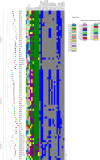Antimicrobial Resistance Mechanisms, Multilocus Sequence Typing, and NG-STAR Sequence Types of Diverse Neisseria gonorrhoeae Isolates in KwaZulu-Natal, South Africa
- PMID: 34280016
- PMCID: PMC8448096
- DOI: 10.1128/AAC.00759-21
Antimicrobial Resistance Mechanisms, Multilocus Sequence Typing, and NG-STAR Sequence Types of Diverse Neisseria gonorrhoeae Isolates in KwaZulu-Natal, South Africa
Abstract
Antimicrobial resistance (AMR) is a major challenge to managing infectious diseases. Africa has the highest incidence of gonorrhoea, but there is a lack of comprehensive data from sparse surveillance programs. This study investigated the molecular epidemiology and AMR profiles of Neisseria gonorrhoeae isolates in KwaZulu-Natal province (KZN), South Africa. Repository isolates from patients attending public health care clinics for sexually transmitted infection (STI) care were used for phenotypic and genotypic analysis. An Etest was performed to determine antimicrobial susceptibility. Whole-genome sequencing (WGS) was used to determine epidemiology and to predict susceptibility by detecting resistance-associated genes and mutations. Among the 61 isolates, multiple sequence types were identified. Six isolates were novel, as determined by multilocus sequence typing. N. gonorrhoeae sequence typing for antimicrobial resistance (NG-STAR) determined 48 sequence types, of which 35 isolates had novel antimicrobial profiles. Two novel penA alleles and eight novel mtrR alleles were identified. Point mutations were detected in gyrA, parC, mtrR, penA, ponA, and porB1. This study revealed a high prevalence of AMR (penicillin 67%, tetracycline 89%, and ciprofloxacin 52%). However, spectinomycin, cefixime, ceftriaxone, and azithromycin remained 100% effective. This study is one of the first to comprehensively describe the epidemiology and AMR of N. gonorrhoeae in KZN, South Africa and Africa, using WGS. KZN has a wide strain diversity and most of these sequence types have been detected in multiple countries; however, more than half of our isolates have novel antimicrobial profiles. Continued surveillance is crucial to monitor the emergence of resistance to cefixime, ceftriaxone, and azithromycin.
Keywords: AMR; gonorrhoea; sexually transmitted diseases.
Figures


Similar articles
-
Antimicrobial susceptibility profile of Neisseria gonorrhoeae from patients attending a medical laboratory, Institut Pasteur de Madagascar between 2014 and 2020: phenotypical and genomic characterisation in a subset of Neisseria gonorrhoeae isolates.Sex Transm Infect. 2024 Jan 17;100(1):25-30. doi: 10.1136/sextrans-2023-055878. Sex Transm Infect. 2024. PMID: 37945345 Free PMC article.
-
Antimicrobial resistance and heterogeneity of Neisseria gonorrhoeae isolated from patients attending sexually transmitted infection clinics in Lusaka, Zambia.BMC Genomics. 2024 Mar 18;25(1):290. doi: 10.1186/s12864-024-10155-y. BMC Genomics. 2024. PMID: 38500064 Free PMC article.
-
Antimicrobial susceptibility of Neisseria gonorrhoeae isolates from symptomatic men attending the Nanjing sexually transmitted diseases clinic (2011-2012): genetic characteristics of isolates with reduced sensitivity to ceftriaxone.BMC Infect Dis. 2014 Nov 27;14:622. doi: 10.1186/s12879-014-0622-0. BMC Infect Dis. 2014. PMID: 25427572 Free PMC article.
-
A systematic review of antimicrobial resistance in Neisseria gonorrhoeae and Mycoplasma genitalium in sub-Saharan Africa.J Antimicrob Chemother. 2022 Jul 28;77(8):2074-2093. doi: 10.1093/jac/dkac159. J Antimicrob Chemother. 2022. PMID: 35578892 Free PMC article.
-
The frequency of mutations in the penA, mtrR, gyrA and parC genes of Neisseria gonorrhoeae, the presence of tetM gene and antibiotic resistance/susceptibility: a systematic review and meta-analyses.Front Microbiol. 2025 Jan 22;15:1414330. doi: 10.3389/fmicb.2024.1414330. eCollection 2024. Front Microbiol. 2025. PMID: 39931279 Free PMC article.
Cited by
-
Combating the menace of antimicrobial resistance in Africa: a review on stewardship, surveillance and diagnostic strategies.Biol Proced Online. 2022 Nov 23;24(1):19. doi: 10.1186/s12575-022-00182-y. Biol Proced Online. 2022. PMID: 36424530 Free PMC article. Review.
-
Whole genome analysis and antimicrobial resistance of Neisseria gonorrhoeae isolates from Ghana.Front Microbiol. 2023 Jun 29;14:1163450. doi: 10.3389/fmicb.2023.1163450. eCollection 2023. Front Microbiol. 2023. PMID: 37455743 Free PMC article.
-
Antimicrobial susceptibility profile of Neisseria gonorrhoeae from patients attending a medical laboratory, Institut Pasteur de Madagascar between 2014 and 2020: phenotypical and genomic characterisation in a subset of Neisseria gonorrhoeae isolates.Sex Transm Infect. 2024 Jan 17;100(1):25-30. doi: 10.1136/sextrans-2023-055878. Sex Transm Infect. 2024. PMID: 37945345 Free PMC article.
-
Doxycycline post-exposure prophylaxis for sexually transmitted infections in South Africa.South Afr J HIV Med. 2023 Sep 28;24(1):1510. doi: 10.4102/sajhivmed.v24i1.1510. eCollection 2023. South Afr J HIV Med. 2023. PMID: 37795430 Free PMC article.
-
Assessment of Antibiotic Resistance and Efflux Pump Gene Expression in Neisseria Gonorrhoeae Isolates from South Africa by Quantitative Real-Time PCR and Regression Analysis.Int J Microbiol. 2022 Oct 21;2022:7318325. doi: 10.1155/2022/7318325. eCollection 2022. Int J Microbiol. 2022. PMID: 36312786 Free PMC article.
References
-
- Christodoulides M (ed). 2019. Neisseria gonorrhoeae: methods and protocols. Methods in molecular biology, vol 1997. Humana Press, Springer US, New York, NY. 10.1007/978-1-4939-9496-0. - DOI
-
- World Health Organization. 2012. Global action plan to control the spread and impact of antimicrobial resistance in Neisseria gonorrhoeae. https://www.who.int/reproductivehealth/publications/rtis/9789241503501/en/.
-
- Johnson RE, Newhall WJ, Papp JR, Knapp JS, Black CM, Gift TL, et al.. 2002. Screening tests to detect Chlamydia trachomatis and Neisseria gonorrhoeae infections–2002. MMWR Recomm Rep 51:1–38. quiz CE1-4. - PubMed
-
- Adachi K, Klausner JD, Bristow CC, Xu J, Ank B, Morgado MG, Watts DH, Weir F, Persing D, Mofenson LM, Veloso VG, Pilotto JH, Joao E, Nielsen-Saines K, NICHD HPTN 040 Study Team. 2015. Chlamydia and gonorrhea in HIV-infected pregnant women and infant HIV transmission. Sex Transm Dis 42:554–565. 10.1097/OLQ.0000000000000340. - DOI - PMC - PubMed
Publication types
MeSH terms
Substances
LinkOut - more resources
Full Text Sources
Medical
Molecular Biology Databases

